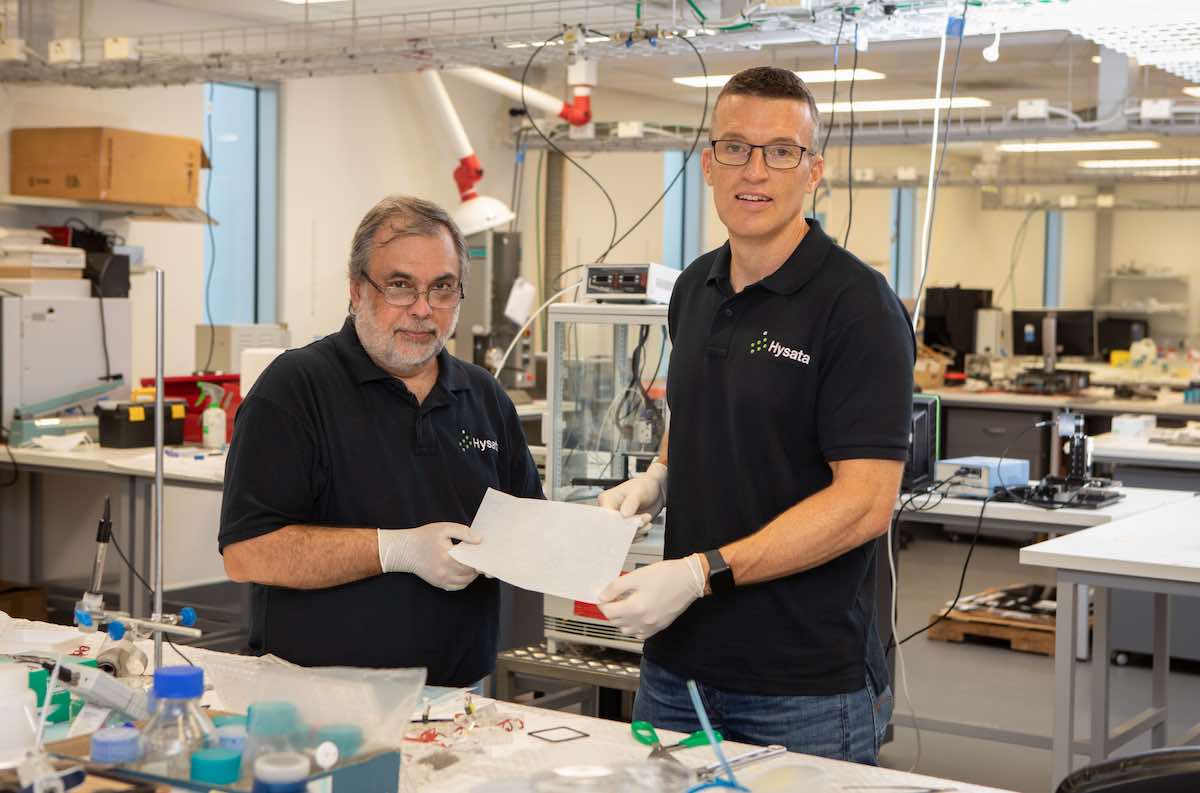Last Friday 6 January I visited Professor Gerhard Swiegers at the Australian Institute for Innovative Materials (AIIM) at the University of Wollongong. He is co-founder of the spin-off company Hysata which is dedicated to the task of scaling up a new technology of water electrolysis termed Capillary Fed Electrolysis (CFE).
This technology could help to usher in a new era of production of green hydrogen at the vast energy scale needed to substitute for fossil fuels across the entire industrial economy.
Professor Swiegers is the chief technology officer of Hysata and leads the laboratory at the AIIM, where the details of the CFE technology was originally developed.
The path to commercialisation is clearly laid out, with Hysata now in receipt of Series A funding worth $42.5 million and plans already advanced for building a new commercial-scale plant just outside Wollongong, designed for pilot-scale production of electrolytic cells based on the new CFE technology. It is anticipated that the pilot plant will be in operation in 2023 and producing the first commercial scale system by 2025.
Professor Swiegers is a serial innovator, being widely published in both the scientific and patent literature, and numerous of his inventions have resulted in successful spin out companies. He has been involved in electrochemistry for over 30 years, developing an insight into chemical processes inspired by those found in living systems, which have been honed to perfection over millions of years.
While earlier work focused on the role of enzymes as molecular machines, providing a template for bio-inspired chemical engineering, the CFE electrolysis cell is the culmination of this work and potentially the most important application. Here is how it works.
Conventional alkaline electrolysers put two electrodes in water, and a permeable membrane between them; as a current is passed through the cell the water dissociates into hydrogen and oxygen molecules with hydroxide ions passing between the electrodes.
The problem with this technology, now more than a century old, is that the electrolytic materials used at the electrodes are expensive (e.g. platinum-group materials) and the evolution of hydrogen at one electrode and oxygen at the other is constrained by formation of bubbles and the resulting electrical resistance.
The latter limits the energy efficiency of the alkaline electrolysers and has constrained production of hydrogen from water to that of a cottage industry rather than the mass manufacturing needed to produce green hydrogen at scale.
The development of a solid polymer membrane between the electrodes (Proton Exchange Membrane PEM) introduced by General Electric in the 1960s did not depart in any fundamental way from this core design.
The CFE electrolytic cell tackles these problems head-on with a radical new solution.
In place of electrolysers with electrodes dipped into a pool of alkaline water, the CFE cell is based on capillary action, mimicking a fundamental biological process found in plants the world over. Trees, for example, draw liquid in the form of sap up the length of their trunk by capillary action, built on inter-molecular forces that drive the sap upwards against the effect of gravity.
The CFE cell utilises this biomimicry principle by introducing an absorbent paper-like material that draws water from a small reservoir at the bottom of the cell.
The water is brought up continuously, into contact with only one side of the electrodes (the inside) via a capillary action that mimics the movement of fluids up from the soil in plants. The hydrogen and oxygen gases can then leave from the other side of the electrodes (the outside), without forming bubbles in the liquid.
This capillary force driving the water up through the CFE cell therefore has the double effect of enhancing the energy efficiency of the cell and eliminating formation of bubbles, which have always constrained the efficiency of conventional alkaline electrolytic cells and PEM cells.
The details of the CFE cell are spelt out in several patent applications taken out to protect the technology now being commercialised by Hysata, and in the article in Nature Communications outlining the viability and practicability of the CFE cell (Hodges et al, Nature Communications, 2022).
The essence of the breakthrough is to utilise the bio-inspired capillary effect to draw water into the cell continuously and provide for hydrogen production and take-off at maximal rate, unencumbered by bubble formation, resulting in an energy efficiency of the cell measured as 98% (reduced down to 95% when including the apparatus and systems surrounding the cell, known as the “balance of plant”).
As the article in Nature puts it, “The aqueous electrolyte is constantly supplied to the electrodes by a spontaneous capillary action in the porous, hydrophilic, inter-electrode separator. The bottom end of the separator is dipped in a reservoir, resulting in capillary-induced, upward … movement of electrolyte.”
It is an ingenious breakthrough to apply to an electrolytic cell producing hydrogen, the same principle that sees trees and plants throughout the world drawing nutrients from the soil via capillary action (against the counter-force of gravity).
The CFE electrolytic cell draws water through the cell continuously by capillary action as opposed to the passive diffusion that characterises the conventional alkaline electrolytic cell and its variant as the PEM cell.
The enhanced energy efficiency results in much higher production of hydrogen per unit of renewable energy supplied. This is because so much less of the renewable energy is wasted (only 5%; vs around 25% wasted with conventional electrolysers).
The authors of the Nature article (including Professor Swiegers) maintain that the resulting improvement in energy productivity of hydrogen production will enable green hydrogen potentially to substitute for fossil fuels as energy carriers and source of electrical power worldwide.
An alternative term to describe the operation of the CFE cell is as a “wicking” device. This is a term inspired by the operation of the wick in a candle, where the candle works because liquid wax is drawn towards the flame by the wick, again using a capillary effect to draw the liquid wax up towards the flame and overcoming the counter-effects of gravity.
The Hysata scientists and engineers refer to the hydrophilic separator in the CFE cell as a wicking device. While its provenance is clear, this use of the term “wicking” is probably not as clear as the term capillary in describing the workings of the CFE electrolytic cell.
In my view it would be preferable to consistently refer to the capillary effect as a superior alternative to the diffusion process that lies at the heart of conventional hydrogen production systems operating as alkaline electrolytic cells.
The Hysata scale-up of electrolysis utilising the CFE cell is targeted at improving the energy efficiency of the process. The workings of the cell reported in the Nature article reach 98% (40.4 kWh/kg) of the theoretical minimum energy needed to produce hydrogen, namely 39.4 kWh per kg hydrogen produced.
These results have recently been independently replicated in full detail by the group of Professor Dan Brett at the Electrochemical Innovation Laboratory of University College London.
Taking into account the Balance of Plant, the energy efficiency of the CFE cell is reported as being 41.5 kWh per kg hydrogen produced (95% efficiency).
The Nature article reports incumbent efficiency as being 52.5 kWh per kg hydrogen produced, an efficiency level of just 75% of the theoretical minimum.
It is this focus on seeking to reach 100% energy efficiency in producing hydrogen that inspired the company’s name: Hysata connotes “Hy” for hydrogen, and “sata” which is Sanskrit for 100 (satam, sata Sanskrit Numbers – वेद Veda (wikidot.com)) – meaning that the company’s goal is to produce hydrogen at close to 100% energy efficiency (i.e. 100% of the theoretical minimum energy needed).
It is worth noting that the version of the CFE cell being developed by Hysata focuses very much on manufacturability, which is consistent with the perspective on renewable energy devices as products of manufacturing and therefore available to all (enhancing energy security) and subject to steady improvements in productivity (as opposed to the diminishing returns that constrain drilling and mining operations).
As outlined by Professor Swiegers and Hysata CEO Paul Barrett, this focus on manufacturability translates into a clear preference for a robust supply chain and on earth-abundant materials in place of the expensive electrode materials used in conventional cells (platinum and iridium group metals).
The same focus has led to a drastic reduction in the water load needed to operate the CFE cell, which is reported to require only 400 Litres of water per MW of capacity, vs around 10,000 L/MW in conventional alkaline systems.
Moreover, the higher efficiency means that far less of the input renewable energy is wasted as heat. The lower cooling requirements mean less energy consumed to cool the electrolyser.
These effects profoundly influence the cost of the hydrogen produced. Overall Hysata scientists and engineers predict that, whereas a project producing 1 million tons of green hydrogen per annum would, using conventional electrolyser technology, require around 14.3GW of renewable energy sources and 7.6GW of electrolysers, the new Hysata technology will produce the same quantity of hydrogen using 11.3GW of renewables and 6GW of electrolysers.
The decrease in the capital cost of the renewable energy sources alone is around $US3 billion – a decline that represents the difference between economic viability and non-viability according to many of Hysata’s customers.
The outstanding level of productivity attributable to these innovative approaches derive from the fundamental design of the CFE cell, now being scaled up by Hysata.
John A. Mathews is Professor Emeritus at Macquarie Business School, Macquarie University Sydney
This article was originally published on the Global Shift Green blog. Republished here with permission. To read the original version, click here.










